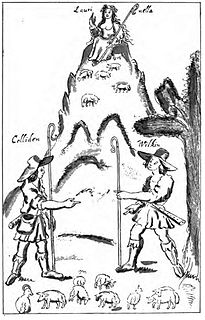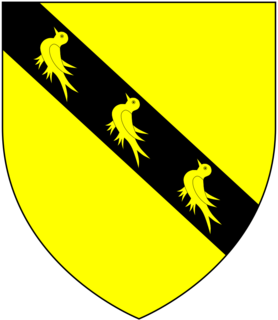
William Oughtred, also Owtred, Uhtred, etc., was an English mathematician and Anglican clergyman. After John Napier invented logarithms and Edmund Gunter created the logarithmic scales upon which slide rules are based, Oughtred was the first to use two such scales sliding by one another to perform direct multiplication and division. He is credited with inventing the slide rule in about 1622. He also introduced the "×" symbol for multiplication and the abbreviations "sin" and "cos" for the sine and cosine functions.
A feghoot is a humorous short story or vignette ending in a pun, where the story contains sufficient context to recognize the punning humor.

William Basse (c.1583–1653?) was an English poet. A follower of Edmund Spenser, he is now remembered principally for an elegy on Shakespeare. He is also noted for his "Angler's song", which was written for Izaak Walton, who included it in The Compleat Angler.
Ben Schott is a British writer, photographer, and author of the Schott's Miscellanies and Schott's Almanac series.
Henry Jacob (1563–1624) was an English clergyman of Calvinist views, who founded a separatist congregation associated with the Brownists.

Henry Jessey or Jacie was one of many English Dissenters. He was a founding member of the Puritan religious sect, the Jacobites. Jessey was considered a Hebrew and a rabbinical scholar. His active philosemitism has led him to be described as "among Israel's greatest seventeenth-century benefactors."

Emery Molyneux was an English Elizabethan maker of globes, mathematical instruments and ordnance. His terrestrial and celestial globes, first published in 1592, were the first to be made in England and the first to be made by an Englishman.

Edward Wright was an English mathematician and cartographer noted for his book Certaine Errors in Navigation, which for the first time explained the mathematical basis of the Mercator projection by building on the works of Pedro Nunes, and set out a reference table giving the linear scale multiplication factor as a function of latitude, calculated for each minute of arc up to a latitude of 75°. This was in fact a table of values of the integral of the secant function, and was the essential step needed to make practical both the making and the navigational use of Mercator charts.

Thomas Harding was an English Roman Catholic priest and controversialist. He was one of the Worthies of Devon of the biographer John Prince (d.1723).
Francis Johnson was an English separatist, or Brownist, minister, pastor to an English exile congregation in the Netherlands.
Nancy Tappan was the co-editor of the newsletter Personal Survival ("P.S.") Letter in the late 1970s and early 1980s. She is now the editor of The New Pioneer magazine. Born Nancy Mack, she is the widow of Mel Tappan.
Thomas Freeman,, was a minor English Jacobean poet and epigramist who is mostly remembered for writing an early poem addressed to Shakespeare. Freeman was born near Moreton-in-Marsh, Gloucestershire, and entered Magdalen College, Oxford, in 1607 at the age of 16 and matriculated with a Bachelor of Arts 22 June 1611.
Abraham Hartwell the elder, was an English poet, who wrote in Latin.

George Baker (1540–1600), was an English surgeon notable for writing and translating a number of early medical texts.
Timothie Bright, M.D. (1551?–1615) was an Early Modern English physician and clergyman, the inventor of modern shorthand.
Thomas Broke or Brooke, translator, was an alderman of Calais, the chief clerk of the exchequer and customer there at the time when the preaching of William Smith at Our Lady's Church in that town led many persons, and Broke among them, to adopt 'reformed' opinions.
Thomas Fale was an English mathematician.
James Roberts, was an English printer who printed many important works of Elizabethan literature. F. G. Fleay says that "he seems to have been given to piracy and invasion of copyright".
Thomas Gainsford was an author and news editor.
"The Field Bazaar" is a short story by Arthur Conan Doyle, first published on November 20, 1896 in a special "Bazaar Number" of The Student, a publication of the students' representative council at Edinburgh University. It is a Sherlock Holmes story, published under Conan Doyle's byline and featuring both Holmes and his partner, Dr. John Watson. It is, however, treated by most experts as a parody or pastiche not suitable for inclusion in the traditional 60-story canon of Sherlock Holmes, though there are dissenters.






